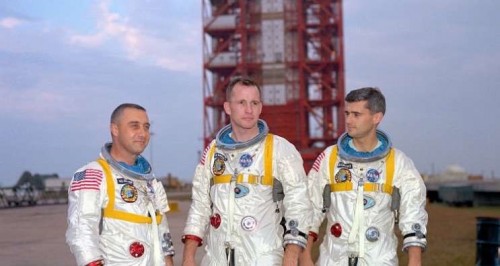Friday 27 January 2017
Fifty years ago today the American space programme had it’s first tragedy – the fire in Apollo 1 that killed Virgil Grissom, Ed White and Roger Chaffee. The fire occurred during a test on the launch pad in preparation for a launch that was scheduled to occur on 21st February 1967. During the hours leading up to the fire there were numerous communications problems which led Gus Grissom the flight commander, who had previously been critical of many problems in the spacecraft and had labeled it a lemon, to say “How are we going to get to the moon if we can’t talk between two or three buildings”. Some time after that a call of “fire” was heard followed by “fire in the cockpit”. The crew did not make it out, despite their own frantic efforts and those of the ground crew battling through toxic smoke. This was mainly down to a complex, three-way, inward opening hatch.
The result of the fire was a 21 month delay in the Apollo programme during which the spacecraft design was greatly improved. As well as the hatch being re-designed to be quick acting and opening outwards, design and manufacturing processes were improved and everything in the vehicle was fire-proofed as far as possible. Procedures were changed, including ground tests being carried out with an atmosphere of air in the capsule instead of the highly flammable pure oxygen used in Apollo 1. In the rush to land on the moon before the end of the 1960s management and workers had become sloppy – the Apollo 1 capsule contained damaged wires and changes had not been well documented. Although the actual ignition source of the fire was never discovered the lowering of standards to make the deadline was a major contributory factor. That is something we should all learn from.
If the fire had not happened Gus Grissom may have been the first man to walk on the moon but it is more likely there would have been a disaster later in the programme, either on the ground or in space, which would probably have stopped the whole project. As it was, three astronauts died horribly but the programme recovered from the tragedy by deeply questioning technologies and procedures and re-doubling its efforts. In October 1968 Apollo 7 tested the revised Command and Service Modules in earth orbit, in December 1968 Apollo 8 orbited the moon, in March 1969 Apollo 9 tested the Lunar Module in earth orbit, in May 1969 Apollo 10 did a complete rehearsal for landing on the moon, and in July 1969 Apollo 11 landed on the moon – a mere two and half years after the Apollo 1 fire. In the modern age where it seems to take forever to do simple things and where we seem to have lost the spirit of exploration, the recovery from the Apollo 7 fire and the subsequent successes of Apollo appears nothing short of miraculous.
“If we die we want people to accept it. We are in a risky business, and we hope that if anything happens to us, it will not delay the program. The conquest of space is worth the risk of life. Our God-given curiosity will force us to go there ourselves because in the final analysis, only man can fully evaluate the moon in terms understandable to other men.”
Gus Grissom
RIP
Virgil I. Grissom, 3rd April 1926 to 27th January 1967
Edward H. White, 14th November 1930 to 27th January 1967
Roger B. Chaffee, 15th February 1935 to 27th January 1967
Comments
Comments are closed.
Dr Steven Fawkes
Welcome to my blog on energy efficiency and energy efficiency financing. The first question people ask is why my blog is called 'only eleven percent' - the answer is here. I look forward to engaging with you!
Tag cloud
Black & Veatch Building technologies Caludie Haignere China Climate co-benefits David Cameron E.On EDF EDF Pulse awards Emissions Energy Energy Bill Energy Efficiency Energy Efficiency Mission energy security Environment Europe FERC Finance Fusion Government Henri Proglio innovation Innovation Gateway investment in energy Investor Confidence Project Investors Jevons paradox M&V Management net zero new technology NorthWestern Energy Stakeholders Nuclear Prime Minister RBS renewables Research survey Technology uk energy policy US USA Wind farmsMy latest entries



